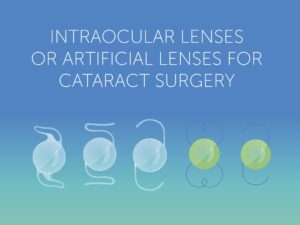When a person gets a cataract, it’s like looking through a foggy window. It makes seeing, reading, or even driving a car hard. Doctors perform surgery where they remove the cloudy lens in the eye and replace it with an artificial one. This new lens is called an intraocular lens (IOL). There are several types of IOLs, each with its benefits. Let’s dive in to learn more about these lenses.
Monofocal IOLs
Monofocal intraocular lenses, or IOLs, are the most common type of lens used in cataract surgery. The word “mono” means one, precisely what these lenses offer – one focus point. This means they are great at helping you see things that are far away. But you might still need your glasses for reading or seeing things close to you.
Monofocal intraocular lenses (IOLs) are popular for people undergoing cataract surgery. Doctors rely on two types of mono-focal lenses: Standard Monofocal IOLs and Aspheric Monofocal IOLs.
- Standard Monofocal IOLs: These are the basic, time-tested option. They help correct nearsightedness (where distant objects appear blurry) or farsightedness (where close-up things are out of focus), but not both. You might still need glasses for certain activities.
- Aspheric Monofocal IOLs: These lenses are like an upgraded version of the standard ones. They’re designed to fix minor issues in your vision, giving you a clearer view of the world. Aspheric lenses simplify tasks like night driving or spotting details in dim light.
Multifocal IOLs
Multifocal intraocular lenses (IOLs) are another type of lens used in cataract surgery. Multifocal lenses work like bifocal or progressive glasses. They help your eyes focus on objects at different distances. Because these lenses help you see clearly at various distances, you might only need your glasses sometimes. Whether driving, reading a menu, or working on your computer, multifocal lenses make these tasks easier.
Here’s what makes them different and potentially beneficial for you:
- Bifocal Multifocal IOLs: These lenses have two focus points. One focus point is seeing things far away, like watching a movie or looking at a beautiful landscape. The other focus point is for seeing things up close, like reading a book or texting on your phone.
- Trifocal Multifocal IOLs: Trifocal lenses are even more versatile. They have three focus points. One is for seeing things up close, another for medium distances like viewing your computer screen, and the third for seeing things far away.

Toric IOLs
Toric lenses are for people with astigmatism, a condition that makes your vision blurry because the shape of your eye isn’t perfectly round. These lenses correct that, helping you see things far away without needing additional glasses.
The Benefits of Accommodating IOLs
Accommodating intraocular lenses, also known as IOLs, are a remarkable solution for cataract surgery patients, as they mimic the behavior of the eye’s natural lens. Here’s how they add value to your vision:
- Mimicking Natural Eye Movements: The standout feature of accommodating lenses is their ability to imitate the natural flexibility of your eye lens. They’re designed to shift or “accommodate” based on the visual demands, making activities like reading a book or recognizing a distant object much more comfortable.
- Offering a Versatile Vision Range: If you love the convenience of seeing clearly at different distances, accommodating lenses have got your back. They offer a broader range of vision than their mono-focal counterparts. Whether you’re admiring a close-up detail, reading a sign at arm’s length, or enjoying a distant panorama, you can rely on these lenses for a clearer view.
- Reducing Dependence on Glasses: With accommodating lenses, your days of constantly searching for reading glasses could be behind you. These lenses help reduce your dependence on glasses for many everyday tasks, allowing you to engage in various activities without an extra pair of glasses.
- Broadening Vision Beyond Monofocal Lenses: While accommodating lenses might not offer the same extensive range as multifocal lenses, they surpass mono-focal lenses in versatility. Accommodating lenses might be your perfect match if you want a balance between clear vision and flexibility.
Selecting the Right Accommodating IOL
Choosing the appropriate intraocular lens (IOL) for your cataract surgery is an important decision that can significantly impact your quality of life post-surgery. Here’s a guide to help you make an informed choice when it comes to accommodating IOLs:
- Consider Your Lifestyle: Think about your daily activities. Do you enjoy reading, painting, or other tasks that require good near vision? Or you often drive or watch movies, activities that demand clear distance vision. An accommodating IOL may be a good fit if you engage in various activities that require shifting focus between near, intermediate, and far.
- Understand the Trade-offs: While accommodating lenses offer a broader range of vision than mono-focal lenses, they might not provide as wide a range as multifocal lenses. It’s crucial to understand this trade-off to set realistic expectations.
- Assess Your Tolerance for Glasses: Accommodating lenses can reduce your reliance on glasses, but they might not eliminate their need. If you want to be entirely free of glasses, discuss this with your doctor to understand whether accommodating IOLs can achieve this for your case.
- Discuss with Your Doctor: Having an open discussion with your eye surgeon is essential. They can provide a detailed assessment of your eyes and guide you through the options. Be sure to communicate your vision goals and lifestyle needs during this discussion.
Contact Us
By taking the time to assess your lifestyle, understand the capabilities of accommodating IOLs, discuss your needs with your doctor, and consider the cost, you can decide whether these lenses are the right choice. Remember, the goal is to enhance your quality of life by achieving the best possible vision after cataract surgery.
Whether you choose a lens for seeing things far away or a lens for seeing at all distances, the best lens is one that fits your life and needs. If you want to learn more about accommodating IOLs, contact the experts at Florida Eye today.



